KARPATHOS - FOLK MUSIC & POETRY
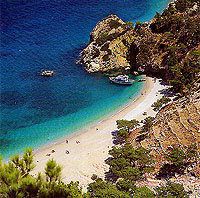 Karpathos
is one of many beautiful islands that grace the Aegean Sea. It has
breathtaking natural beauty and is particularly known for its pristine beaches
which rival the best of the Dodecanese and all of Greece. However, the most
distinguishing element of Karpathos is its people and their deep rooted
culture and traditions. Karpathians are true descendants of Homer. Their
social, spiritual and emotional existence is vividly expressed in their folk
music, dance and poetry all of which have remarkably withstood the test of
time.
Karpathos
is one of many beautiful islands that grace the Aegean Sea. It has
breathtaking natural beauty and is particularly known for its pristine beaches
which rival the best of the Dodecanese and all of Greece. However, the most
distinguishing element of Karpathos is its people and their deep rooted
culture and traditions. Karpathians are true descendants of Homer. Their
social, spiritual and emotional existence is vividly expressed in their folk
music, dance and poetry all of which have remarkably withstood the test of
time.
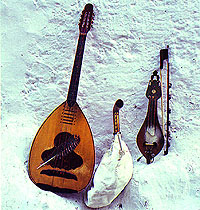 Karpathian music
is played by the descendant of Apollo's lyra which is accompanied by the bag
pipe, called tsambouna, and only in this century by the laouto or lute.
Karpathian dances are unlike most Greek folk dances. They command an imposing
presence and grace through powerful yet austere motion reminiscent of the
dances from Pontos. Poetry, however, has been and still remains the principal
form of emotional and spiritual expression. Karpathians engage in poetry to
lyrically epitomize their private and public lives and emotions.
Karpathian music
is played by the descendant of Apollo's lyra which is accompanied by the bag
pipe, called tsambouna, and only in this century by the laouto or lute.
Karpathian dances are unlike most Greek folk dances. They command an imposing
presence and grace through powerful yet austere motion reminiscent of the
dances from Pontos. Poetry, however, has been and still remains the principal
form of emotional and spiritual expression. Karpathians engage in poetry to
lyrically epitomize their private and public lives and emotions.
Karpathian folk poetry is based on the "mantinatha" which is composed of two,
fifteen syllable, rhyming verses of iambic rhythm identical to Homer's epics.
The mantinatha is still used, to an equal or lesser extent, in other places
such as Cyprus, Crete, Kassos and other islands of the Aegean.
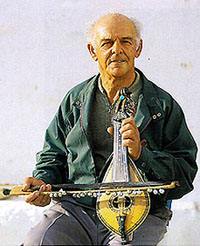 There are two basic categories of mantinatha: (a) those composed spontaneously
and sung in public as part of social and family gatherings, and (b) those
planned and composed privately and communicated in writing. They convey
thoughts and emotions about happiness, sorrow, personal experiences, love and
romance, private, social and even political events.
There are two basic categories of mantinatha: (a) those composed spontaneously
and sung in public as part of social and family gatherings, and (b) those
planned and composed privately and communicated in writing. They convey
thoughts and emotions about happiness, sorrow, personal experiences, love and
romance, private, social and even political events.
In social gatherings such as weddings, baptisms, religious festivals and, in
particular, impromptu parties, Karpathians engage in poetic dialog for hours
and sometimes days. In such parties or "glendia", typically held in coffee
shops or tavernas, participants gather around folk musicians where they
compose and sing mantinathas to each other.
Their spontaneous compositions are sung to folk melodies called skopee. These
melodies vary in length, tempo, and complexity. By most accounts there are
about 40 known skopee some of which are not even identified by name. Singers
master a number of skopee and sing each mantinatha to the tune that best
conveys its emotion and context.
Each singer will sing two to three mantinathas on a topic that is being
deliberated by the "parea" or group of participants. He composes each
mantinatha in real time and most often begins to sing one without quite
knowing how to finish it. Such improvisation is assisted by the way
mantinathas are sung and the extended timing of their melodies. The singer
vocalizes the first half of the first verse which is repeated by the parea in
chorus. The singer then repeats the first half and completes the first verse
which is also repeated by the chorus. He completes the mantinatha by singing
the second verse in the same manner. This conversation in verse is continued
by others until the topic is exhausted and someone introduces another.
The next piece is from a glendi celebrating a
baptism at a picturesque chapel in Mertonas, Karpathos.
The deeply moved
grandfather
sings as his name passes on to his grandchild.
As indicated above, context as well as melody are used as an ensemble to
communicate thoughts and emotions. Some skopee are fast, some slow, others are
sad and others are gay. There are simple ones that are easy to learn, and
quite complex ones that are mastered by the few and very skilled. Skopee are
rendered with small yet significant variations from village to village or
geographical area, but are also heavily influenced by the individual
interpretation of folk musicians and singers. As in american jazz and blues,
improvisation is applied equally to lyrics and music.
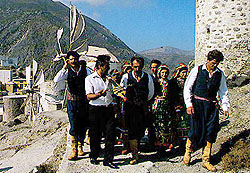 Next we have an example of diversity in style and interpretation
in singing and playing the melody of
skopos tis niktas.
The first sample is from Kassos, the second and last samples
are from the villages of Othos and Olympos, Karpathos.
All expressions are true to the basic melody, yet the variation
in style is refreshing.
Notice the slower tempo of the Kassos version and the
emotion of the singer in the last sample.
Next we have an example of diversity in style and interpretation
in singing and playing the melody of
skopos tis niktas.
The first sample is from Kassos, the second and last samples
are from the villages of Othos and Olympos, Karpathos.
All expressions are true to the basic melody, yet the variation
in style is refreshing.
Notice the slower tempo of the Kassos version and the
emotion of the singer in the last sample.
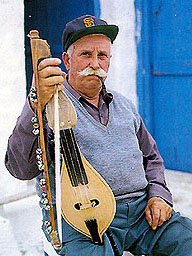 Mantinathas are also synthesized outside of the spontaneous and dynamic
setting of the glendi. They are prepared with care and usually addressed to
loved ones privately, or openly during family events such as baptisms and
weddings. Mantinathas are also prepared and published as commentary or satire
on social and political issues, as well as, historical events. In some cases,
mantinathas are composed as a form of personal diary.
Mantinathas are also synthesized outside of the spontaneous and dynamic
setting of the glendi. They are prepared with care and usually addressed to
loved ones privately, or openly during family events such as baptisms and
weddings. Mantinathas are also prepared and published as commentary or satire
on social and political issues, as well as, historical events. In some cases,
mantinathas are composed as a form of personal diary.
The following is a poem, originally part of a letter from a
mother to her son, expressing her love and longing for his return to the island.
The poem was later set to music and
performed
by Marigoula Kritsiotis from Othos, Karpathos.
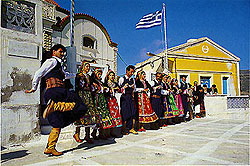 As mentioned earlier, Karpathian musical tradition is diverse in style
geographically and interpretation individually. It has, however, been
preserved faithfully and remains practically unchanged over the last one
hundred years. One noteworthy exception reflective of modern times has been
the increasingly faster tempo of dance music.
This is demonstrated on the
pano choros dance:
the slow tempo on the first piece recorded by Baud-Bovy in 1935,
the lavish inflections of Papaminas' lyra in 1976.
and the raw energy of Sofillas in 1995.
As mentioned earlier, Karpathian musical tradition is diverse in style
geographically and interpretation individually. It has, however, been
preserved faithfully and remains practically unchanged over the last one
hundred years. One noteworthy exception reflective of modern times has been
the increasingly faster tempo of dance music.
This is demonstrated on the
pano choros dance:
the slow tempo on the first piece recorded by Baud-Bovy in 1935,
the lavish inflections of Papaminas' lyra in 1976.
and the raw energy of Sofillas in 1995.
Music and poetry identify the Karpathian soul, express its pathos and ethos,
and forge an unbreakable bond with the motherland. They are a live tradition
and an integral part of every day life. Young people continue to engage in
them with respect and enthusiasm. By learning how to sing and dance through
active participation in the traditional glendi, they are helping preserve
tradition and ensure its continuity and relevance.
We will say goodby with the music of another dance called
Sousta performed by
Minas Papaminas in Baltimore, Maryland.
BACK
 Pericles Lagonikos
Pericles Lagonikos
(c) Apella Nota, 1998.
 Karpathos
is one of many beautiful islands that grace the Aegean Sea. It has
breathtaking natural beauty and is particularly known for its pristine beaches
which rival the best of the Dodecanese and all of Greece. However, the most
distinguishing element of Karpathos is its people and their deep rooted
culture and traditions. Karpathians are true descendants of Homer. Their
social, spiritual and emotional existence is vividly expressed in their folk
music, dance and poetry all of which have remarkably withstood the test of
time.
Karpathos
is one of many beautiful islands that grace the Aegean Sea. It has
breathtaking natural beauty and is particularly known for its pristine beaches
which rival the best of the Dodecanese and all of Greece. However, the most
distinguishing element of Karpathos is its people and their deep rooted
culture and traditions. Karpathians are true descendants of Homer. Their
social, spiritual and emotional existence is vividly expressed in their folk
music, dance and poetry all of which have remarkably withstood the test of
time.

 There are two basic categories of mantinatha: (a) those composed spontaneously
and sung in public as part of social and family gatherings, and (b) those
planned and composed privately and communicated in writing. They convey
thoughts and emotions about happiness, sorrow, personal experiences, love and
romance, private, social and even political events.
There are two basic categories of mantinatha: (a) those composed spontaneously
and sung in public as part of social and family gatherings, and (b) those
planned and composed privately and communicated in writing. They convey
thoughts and emotions about happiness, sorrow, personal experiences, love and
romance, private, social and even political events.
 Next we have an example of diversity in style and interpretation
in singing and playing the melody of
Next we have an example of diversity in style and interpretation
in singing and playing the melody of
 Mantinathas are also synthesized outside of the spontaneous and dynamic
setting of the glendi. They are prepared with care and usually addressed to
loved ones privately, or openly during family events such as baptisms and
weddings. Mantinathas are also prepared and published as commentary or satire
on social and political issues, as well as, historical events. In some cases,
mantinathas are composed as a form of personal diary.
Mantinathas are also synthesized outside of the spontaneous and dynamic
setting of the glendi. They are prepared with care and usually addressed to
loved ones privately, or openly during family events such as baptisms and
weddings. Mantinathas are also prepared and published as commentary or satire
on social and political issues, as well as, historical events. In some cases,
mantinathas are composed as a form of personal diary.
 As mentioned earlier, Karpathian musical tradition is diverse in style
geographically and interpretation individually. It has, however, been
preserved faithfully and remains practically unchanged over the last one
hundred years. One noteworthy exception reflective of modern times has been
the increasingly faster tempo of dance music.
This is demonstrated on the
As mentioned earlier, Karpathian musical tradition is diverse in style
geographically and interpretation individually. It has, however, been
preserved faithfully and remains practically unchanged over the last one
hundred years. One noteworthy exception reflective of modern times has been
the increasingly faster tempo of dance music.
This is demonstrated on the
 Pericles Lagonikos
Pericles Lagonikos